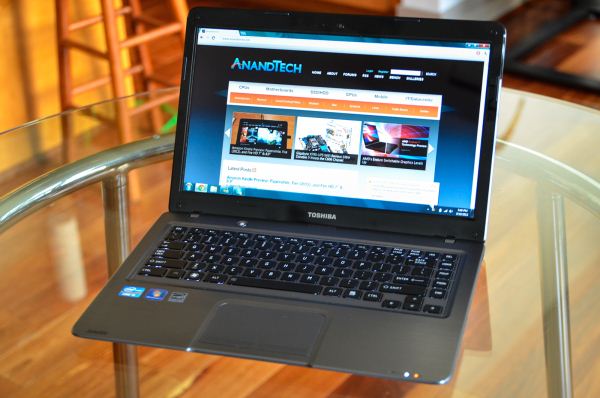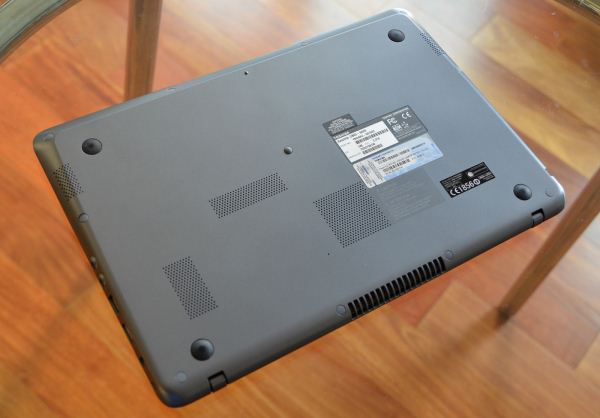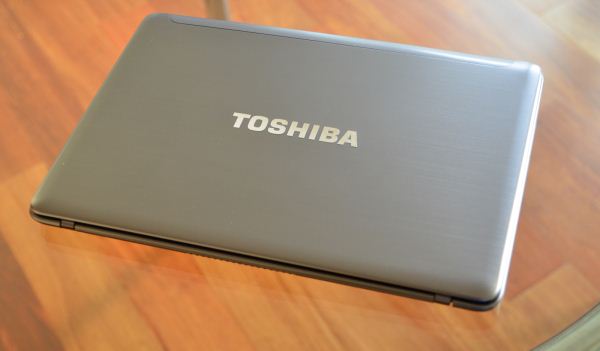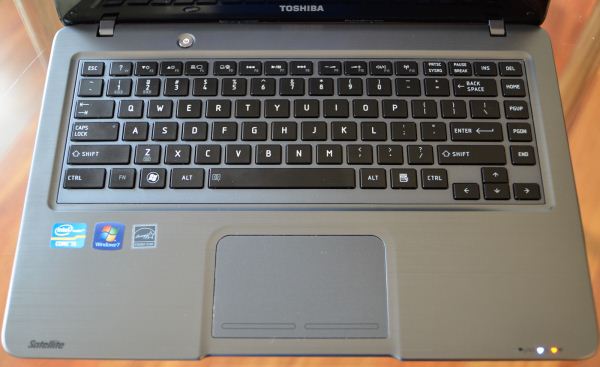Toshiba Satellite U845: Ultrabooks Go Mainstream
by Vivek Gowri on October 8, 2012 5:00 PM EST- Posted in
- Laptops
- Intel
- Toshiba
- Ivy Bridge
- Ultrabook
From a design standpoint, the U845 is pretty decent, and much better than I’m used to seeing from Toshiba. The chassis is made of exactly two pieces, just a top half and a bottom half, similar to the unibody style of notebook design. Unlike the traditional unibody, which has a wraparound top half and a bottom piece that mounts up to it (think of the panel on MacBook Pros that covers the entirety of the underside), the U845 has a panel on top that drops onto the wraparound bottom half. The bottom half is plastic, while the top panel is brushed aluminum, a treatment similar to what HP has done for their Envy Sleekbook/Ultrabook chassis (which also has the bottom unibody and top panel construction).
I suspect that it’s simply cheaper to have a plastic bottom unibody with a metal panel on top, because you still get the metal look and feel on the palmrests without having to actually carve the majority of the chassis out of a single block of metal. Having a simple aluminum plate means less material and less machining, which means way less cost. Once you start having to mill out openings for ports, I can completely understand how you would make a financially motivated decision to go with an injection molded plastic part, where creating the tooling is the major expense and things like material cost and machining are comparatively very minor.
The bottom is completely free of easy upgrade access ports, so I suspect that attempting to upgrade this system will be a pain—making the initial upgrade to 6GB memory probably worth it in the long run (though it would be nice to see an 8GB option as well). That’s actually the big downside in unibody designs, particularly ones with wraparound bottoms: you have to take two-thirds of the chassis off just to get access to basic memory and storage components. I thought the way Apple handled this with their unibody MacBook Pros was great, at least until they started making everything non-upgradable.
My chief complaint with the industrial design? The LCD bezel. It’s ridiculous; why companies feel the need to put a glossy black bezel around an already glossy display is something I continually find myself asking. It’s distracting, and it goes a long way towards cheapening the look.
The U845 aesthetic is mostly clean and inoffensive (notable exception: LCD bezel), but it doesn’t have the same premium look as many of the 13” Ultrabooks out there. Which is basically what I expected, but what really surprised me about this design was the build quality. It feels solid and well put together, which is unexpected because, let’s face it, this is a midrange Toshiba. No offense, but over the last half decade or so, the Satellite line hasn’t done a whole lot to inspire respect or confidence. The higher end Portege models have been decent, but the Satellites are a different story—they're generally mediocre systems that tend to be designed and built to standards lower than expected. The U845 is different, and that’s a very good thing.
The unibody construction has done wonders here, helping the entire notebook feel sturdier by having less parts to deal with, and the aluminum upper casing has done the job by keeping the palmrest and interior stable and flex-free. Overall, the system feels reassuringly weighty, and to be honest, I think it’s built better than the Samsung Series 5 Ultra. That’s an important step forward for Toshiba, being able to tout build quality in their midrange notebook products. I’m a fan.
The input device combination is a bit of a mixed bag, with a multitouch trackpad with Synaptics drivers and their standard suite of gesture support. The click is a bit firm for my tastes, but the pad itself is responsive and has good sensitivity. The keyboard is somewhat unfortunate—it looks and feels just like the keyboard from the R700, none of which is good. It’s stable enough in normal use, but it exhibits flex under pressure. The biggest issue is that the typing feel is pretty mushy. You get used to the absence of adequate feedback, but the lack of positive keypresses is still an issue for Toshiba, and the lack of improvement in that area over the last three years is rather disappointing. But other than the keyboard and LCD bezel, the hardware is surprisingly robust, a definite positive for Toshiba.














57 Comments
View All Comments
Bull Dog - Tuesday, October 9, 2012 - link
While I understand where some of the other commenters are coming from with regards to seeing a 1366x768 display and not bothering to read further, I am disappointed by the apparent lack of appreciation for Vivek's hard work in actually reviewing the product.I too, abhor low-rez, low-quality panels as much as the next guy. These low quality LCD screens need to die, three years ago. And this notebook in particular is even worse than "normal'.
That all being said, I still enjoy reading through the review in it's entirety. My thanks to all the hard work that the Anandtech crew does to make these reviews happen.
KaarlisK - Tuesday, October 9, 2012 - link
Basically, the idea is to replace the mSATA SSD with a 128/256gb SSD, disable SRT, and use it as a laptop with two drives. Is this possible (does the bios/Intel RST driver allow this option?)?nbgambler - Wednesday, October 10, 2012 - link
I second this... This, and a reasonably priced mSATA drive, would go a long way to un-mass market a lot of these laptops!StrangerGuy - Tuesday, October 9, 2012 - link
We need to slap designers repeatedly in the face until they get the message of:NOBODY WANTS GLOSSY SURFACES OTHER THAN THE SCREEN...GET IT?
hybrid2d4x4 - Tuesday, October 9, 2012 - link
That should say "NOBODY WANTS GLOSSY SURFACES." (emphasis on the period)Belard - Wednesday, October 10, 2012 - link
Only the power light can be glossy.Calista - Wednesday, October 10, 2012 - link
You guys seem to have such short memory, it was only a few years ago that glossy plastic was all the rage while dull matte plastics was considered low-end. And yes, I'm sure you bought those products as well, support the very same design you now moan at.Hrel - Tuesday, October 9, 2012 - link
I agree with others. The whole idea of the "ultrabook" brand is to guarantee consumes a higher level of quality and refinement than most are used to; ie those cheap 300-500 dollar notebooks. Intel places requirements on ultrabooks, to use that brand, I cannot fathom why one of those requirements isn't AT LEAST a 1600x900 screen with a brightness of AT LEAST 300cd/2 and a contrast of at least 300:1, preferably 500:1.I don't really want to pay for an SSD. But use a Seagate Hybride 500GB or 750GB drive. They'll probably have a hybrid 1TB 2.5" drive out soon too. I have the 500GB one in my gaming laptop right now. Let me tell you, the difference between loading levels on my desktop (RAID 0) and on my laptop is night and day. I don't even want to play Mass Effect on my desktop anymore because the load times are literally 10 times longer. At the same time I couldn't possibly get by with anything below 500GB; even that is kind of a pain to have to manage. So having only an SSD in anything is out of the question, because 512GB SSD's are just too expensive.
nbgambler - Wednesday, October 10, 2012 - link
By no means blazing fast write speeds, but for the gamers among us, a sub $300 512GB SSD ($0.58 per GB) solves most storage problems I can think of!http://www.amazon.com/OCZ-Technology-2-5-Inch-Max-...
Belard - Wednesday, October 10, 2012 - link
OUCH!! $300.... we are getting there. But honestly, a hybrid setup still works pretty good. $150 80~160GB SSD + $100 1 or 2 TB HD.Yeah, the point of the "ultrabook" is a level of quality and specs... which this thing is not.
There is a reason Apple is selling a lot of $1000~2500 notebooks... as much as I hate Apple, their hardware is consistent.
Toshiba Satellite U845
Zenbook UX31E.
ACER M3-581TG... Notice something about these? The NAMES!
What the hell is a M3-581TG or UX31 or U845? "OMG!! I got the M3-581TG, I've been dreaming about this notebook for weeks" - doesn't happen. Who really knows those names?
Go to Apple: MacBook Air (11 or 13") , MacBook Pro, iMac, Mac, etc.
How about ThinkPad? They at least keep the model names for years. T400~T430...